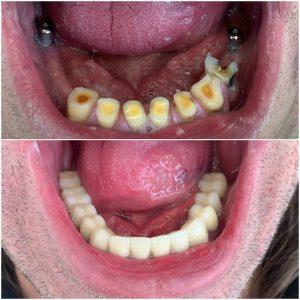Dental Implants
Implantology is a branch of dentistry that deals with replacing lost teeth by inserting dental implants.
Although the first knowledge on this topic dates back to 1913, it still raises numerous uncertainties and questions among people.
For this reason, we will provide answers to the most common questions here to help you understand and alleviate the fear that ignorance can create because trust us, there is no room for fear when it comes to this surgical procedure.



What are dental implants?
Dental implants are artificial replacements for missing teeth. They are structures that mimic the root of a tooth and allow for the creation of appropriate crowns on top of them. They are made of titanium, a biocompatible material that forms a strong bond with the bone after a certain period. In simpler terms, it’s like a “screw” in the bone on which crowns, bridges, or dentures are made.
Why do I need dental implants?
Dental implants represent the pinnacle of world dentistry, and to our great pleasure, they are also performed at this level here. They provide a unique way to replace teeth, achieving a beautiful and complete smile that has become a requirement of modern society. Besides aesthetics, they restore the full function of chewing and elevate the quality of life to a top-notch level.
Am I a candidate for dental implants?
If a patient is completely without teeth or has a shortened dental arch, they may be a candidate for implants. However, this is not the only criterion. It is essential to determine the patient’s oral condition first through a three-dimensional X-ray – a 3D orthopantomogram. This X ray provides the dentist with insight into all surrounding anatomical structures as well as the condition of the remaining teeth and bone. Only after such a detailed examination will the doctor provide you with a possible treatment plan.
Indications and contraindications
For this type of therapy, there are almost no contraindications. The success rate in healthy patients is nearly 100%. Certain chronic illnesses may reduce this percentage, but even then, the therapy is possible.
Is the procedure itself painful?
The answer to this question is simple – no! The procedure is performed under local anesthesia, using modern techniques, making it almost easier than tooth extraction. If fear prevails, it is possible to have the procedure done under sedation in collaboration with an anesthesiologist to eliminate any worries.
What does the dental implant placement procedure look like?
After the examination and the treatment plan are determined, there are two phases that separate you from a radiant smile. In the first, surgical phase, the implant is placed in the bone. The duration of this phase depends on the number of implants being placed, which can range from 1 to 12 for completely edentulous patients. After this phase and the healing of the compromised mucosa, it takes a minimum of 3 months for proper osseointegration, i.e., complete implant integration with the bone. During this time, the patient can return to their daily activities as the implanted structures are not visible in the mouth. The second phase involves the prosthetic part. Firstly, the implant is uncovered, and sulcus formers, i.e., metal structures that he patient wears for 7 days, are placed. Their role is to shape the space for future crowns. After this week, the final stage of the procedure begins. Crowns or bridges are made, which only take a few days to complete. The patient chooses the appearance of their new smile, but our experienced doctors are available for advice and suggestions. There is a wide range of tooth shades available, from the most natural, almost natural colors, to the brightest bleach variations. Together, we find the ideal color, shape, and size of teeth and the smile you will leave our office satisfied with.
